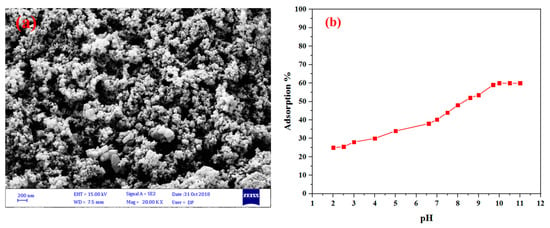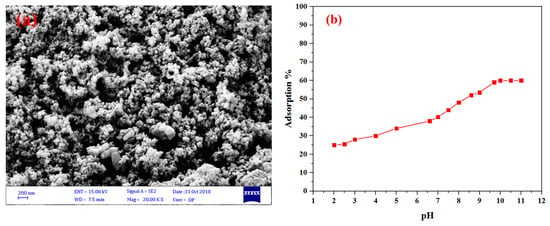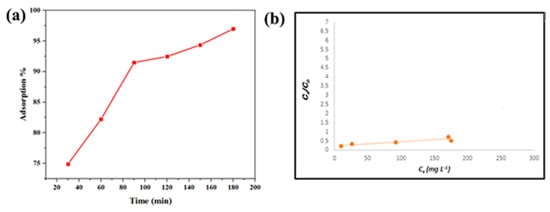Abstract
The activated carbon was prepared from an almond shell, which is chemically activated by H2SO4. In the present study, the adsorption of rhodamine-B from water by activated carbon has been investigated and compared. The effect of pH value, initial concentration of dissolved and amount of adsorbent on the adsorption of rhodamine-B by the mentioned adsorbents were investigated. Results showed that the adsorption process was highly dependent on pH. Maximum rhodamine-B removal was achieved when the final pH is 11. Maximum rhodamine-B removal efficiencies were obtained by an almond shell (70%). Adsorption test results revealed that rhodamine-B adsorption on the studied adsorbents could be better described by Langmuir isotherm.
1. Introduction
In a generic aquatic perimeter, organic dyes such as rhodamine-B are too difficult to remove from the aqueous media, causing harm to the receiving water bodies; moreover, some dyes are toxic and doubtful carcinogens [1]. Rhodamine-B is widely used in tissues and foodstuff as one of the most main colorants [2]. Dyes are difficult to remove by contractual wastewater filtration treatments because of their high stability versus light, temperature, chemical, and microbial attacks [3]. One of the most widely used crops for the removal of these contaminants are activated carbons (activated charcoals), which can be created from agricultural residues such as almond shell, olive-waste, grass clippings, horse manure, rice ski waste, etc. [4]. The adsorption method is used for the treatment of artful effluents, and activated carbon is vastly used for the removal of many polluters, but it has the detriment of having a high expense. Resultantly, other low-cost materials have been proposed as alternatives, in particular relict biomass, which is a natural biodegradable renewable crop, with an accepted version minimum associated price and which also has good adsorption attributes for contaminants, either metals or chemical compositions [5]. Activated carbon of plant principle is a versatile adsorbent of great economic profit for the treatment of water, either for human waste or for industrial purposes. The aim of this study is to produce activated carbon from almond shell by chemical activation method for the removal of rhodamine-B as organic pigment from aqueous perimeter. The mechanisms of rhodamine-B uptake have been investigated through isotherms studies. In addition, the effect of pH and concentration on the removal of rhodamine-B from the aqueous medium was also investigated.
2. Experimental Section
2.1. General
All chemicals used were of analytical grade and used as received.
The FTIR spectra were recorded on a Shimadzu-FT-IR 8400S spectrophotometer from 400 to 4000 cm−1. X-ray diffraction patterns were carried out on PHILIPS-PW 1800 A diffractometer with monochromatized Cu Kα radiation λ = 1.542 Å. The Brunauer–Emmett–Teller (BET) surface zones and pore structure of AC were defined by N2 adsorption/desorption isotherms at 77K. Morphology of samples using an electron microscope (VEGA-TESCAN (with gold coating)) was analyzed.
2.2. Activated Carbon Preparation
The chemical activation of the raw material was transported out using sulfuric acid. Before impregnating the material, it was first powdered and sanded using a homemade milling machine (mesh 10). Subsequently, the materials were impregnated with solution of sulfuric acid using 8.5 g of almond shell in 32 mL of the respective solution (H2SO4) for 3 h. After saturation, the sample was filtered and dried at 110 °C for 24 h. For chemical activation of the sample with sulfuric acid, the sample was heated to 500 °C in the furnace. The product was then rinsed (pH = 6–7) with distilled water, and dried at 110 °C for 4 h [6].
3. Adsorption Experiments
For the parity experiment, 0.5 g of activated carbon was added into 50 mL of rhodamine-B solution at a suite of known initial concentrations (C0). After stirring the samples for 24 h with an agitator, the equilibrium condensation of rhodamine-B in the solution (Ce) was determined by UV–visible spectrophotometry at 556 nm. The value of the adsorbed pollutants on the adsorbent was calculated by Equation (1):
where qe is adsorbed amount on the adsorbents (mg/g), C0 and Ce are expressed in mg/mL, V is the solution volume (mL), and m is the adsorbents mass (g).
4. Results and Discussion
The chemical structure and functional group of the gathered activated carbon have been studied by FTIR spectroscopy (Figure 1a). The peak at 2824 cm−1 is related to the symmetric and asymmetric C–H stretching vibrations of aliphatic acids. The broad and drastic adsorption peaks at 3413 cm−1 belongs to O–H stretching vibrations. The observed peak at 1618 cm−1 is due to C = C stretching that can be ascribed to the aromatic C–C bond. The peak at 1077 cm−1 is attributed to C–H in area [7]. For activated carbon under study, the X-ray powder diffraction pattern (Figure 1b) shows the presence of broad peaks, indicating that utmost of the sample are amorphous, which is a typical specific of porous adsorbents [8].

Figure 1.
(a) FT-IR spectrum and (b) XRD pattern of activated carbon.
The surface area, pore size, and average diameter of the particles produced are given in Table 1.

Table 1.
Parameters of activated carbon obtained from the nitrogen adsorption isotherms.
The SEM image of activated carbon (Figure 2a) shows that activated carbon has a structure full of pore. The pH effect on rhodamine-B removal is shown in Figure 2b. When the initial pH of the solution increases from 2 to 11, the removal percentage of the color is also increased. However, the maximum adsorption of the dye was obtained at pH = 11, viz. 70% in the case of activated carbon. Lower adsorption of rhodamine-B is at acidic pH because of the tendency of excess H+ ions corralling with the dye cation for the adsorption sites [7].

Figure 2.
(a) The SEM image of activated carbon. (b) Effect of pH on the removal of rhodamine-B by activated carbon.
The curves given in Figure 3a shows that the removal of the color at the early stages of the contact time was quick and decreased with time as the balance went down. More catalyst can adsorb more pigment. The Langmuir mechanism diagram is shown in Figure 3b.

Figure 3.
(a) Effect of time on the removal of rhodamine-B by activated carbon. (b) Langmuir adsorption isotherms for the rhodamine B.
The correlation coefficient (R2) indicating the proximity of the results shows the mechanism under study. When the value is closer to 1, it is clear that the reaction is more likely to follow it. KL, single-layer energy, AL, Langmuir constant, Qm monolayer adsorption capacity requirements (Table 2).

Table 2.
Langmuir isotherm model parameters for rhodamine-B adsorption on active carbon.
5. Conclusions
This study shows the preparation of activated carbon from almond shell, an agricultural waste, by the chemical activation method. Adsorption studies have been conducted for the activated carbon obtained from the almond shell to assess the capability to remove rhodamine-B in the aqueous phase. Eventually, results showed that the adsorption process was highly dependent on pH. Maximum rhodamine-B removal was at pH = 11. Maximum rhodamine-B removal efficiency was obtained by almond shell (70%). Adsorption test results revealed that rhodamine-B adsorption on the studied adsorbents was better described by Longmuir isotherm.
References
- Butt, M.T.; Arif, F.; Shafique, T.; Imtiaz, N. Spectrophotometric estimation of colour in textile dyeing wastewater. J. Chem. Soc. Pak. 2005, 27, 627–630. [Google Scholar]
- Bao, L.; Meng, M.; Sun, K.; Li, W.; Zhao, D.; Li, H.; He, M. Selective adsorption and degradation of Rhodamine B with modified titanium dioxide photocatalyst. J. Appl. Polym. Sci. 2014, 131, 40896–40908. [Google Scholar] [CrossRef]
- Badmus, M.A.O.; Audu, T.O.K. Periwinkle shell: Based granular activated carbon for treatment of chemical oxygen demand (COD) in industrial wastewater. Can. J. Chem. Eng. 2009, 87, 69–77. [Google Scholar] [CrossRef]
- Klasson, K.T.; Wartelle, L.H.; Rodgers, J.E., III; Lima, I.M. Copper (II) adsorption by activated carbons from pecan shells: Effect of oxygen level during activation. Ind. Crops Prod. 2009, 30, 72–77. [Google Scholar] [CrossRef]
- Paraskeva, P.; Kalderis, D.; Diamadopoulos, E. Production of activated carbon from agricultural by-products. J.Chem. Technol. Biotechnol. 2008, 83, 581–592. [Google Scholar] [CrossRef]
- Montoya, V.H.; Bonilla-Petriciolet, A. (Eds.) Lignocellulosic Precursors Used in the Synthesis of Activated Carbon: Characterization Techniques and Applications in the Wastewater Treatment; InTech: Mexico, 2012. [Google Scholar]
- Mehrasbi, M.R.; Farahmandkia, Z.; Taghibeigloo, B.; Taromi, A. Adsorption of lead and cadmium from aqueous solution by using almond shells. Water Air Soil Pollut. 2009, 199, 343–351. [Google Scholar] [CrossRef]
- Bouchelta, C.; Medjram, M.S.; Bertrand, O.; Bellat, J.P. Preparation and characterization of activated carbon from date stones by physical activation with steam. J. Anal. Appl. Pyrolysis 2008, 82, 70–77. [Google Scholar] [CrossRef]
Publisher’s Note: MDPI stays neutral with regard to jurisdictional claims in published maps and institutional affiliations. |
© 2019 by the authors. Licensee MDPI, Basel, Switzerland. This article is an open access article distributed under the terms and conditions of the Creative Commons Attribution (CC BY) license (https://creativecommons.org/licenses/by/4.0/).